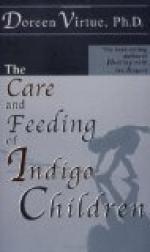II. INFANT FEEDING
Nursing
Weaning
Artificial Feeding
Selection and Care of Milk Used for Infant Feeding
Modification of Cow’s Milk
Food for Healthy Infants—The Early Months
Food for Healthy Infants—The Later Months
General Rules for Guidance in the Use of the Formulas
Given
Addition of Other Foods to Milk
Overfeeding
Loss of Appetite
Changes in Food Required by Special Symptoms or Conditions
Common Mistakes in Milk Modification and Infant Feeding
Preparation of Cow’s Milk at Home
Directions for Feeding Infants
Intervals of Feeding
Regularity in Feeding
Sterilized Milk
Modified Milk of the Milk Laboratories
Peptonized Milk
Feeding During the Second Year
Feeding During the Third Year
III. THE DIET OF OLDER CHILDREN
Milk and Cream
Eggs
Meats and Fish
Vegetables
Cereals
Broths and Soups
Bread, Crackers, and Cakes
Desserts
Fruits
Indigestion in Older Children
General Rules to be Observed in Feeding
Food Formulas
IV. MISCELLANEOUS
Bowels
Sleep
Exercise
Cry
Lifting Children
Temperature
Nervousness
Toys
Kissing
Convulsions
Foreign Bodies
Colic
Earache
Croup
Contagious Diseases
Scurvy
Constipation
Diarrhoea
Bad Habits
Vaccination
Weight Charts
THE CARE AND FEEDING OF CHILDREN
PART I
THE CARE OF CHILDREN
BATHING
At what age may a child be given a full tub bath?
Usually when ten days old; it should not be given before the cord has come off.
How should the bath be given?
It should not be given sooner than one hour after feeding. The room should be warm; if possible there should be an open fire. The head and face should first be washed and dried; then the body should be soaped and the infant placed in the tub with its body well supported by the hand of the nurse. The bath should be given quickly, and the body dried rapidly with a soft towel, but with very little rubbing.
At what temperature should the bath be given?
For the first few weeks at 100 deg. F.; later, during early infancy, at 98 deg. F.; after six months, at 95 deg. F.; during the second year, from 85 deg. to 90 deg. F.
With what should the bath be given?
Soft sponges are useful for bathing the body, limbs and scalp. There should be a separate wash-cloth for the face and another for the buttocks.
What are the objections to bath sponges?
When used frequently, they become very dirty and are liable to cause infection of the eyes, mouth or genital organs.




